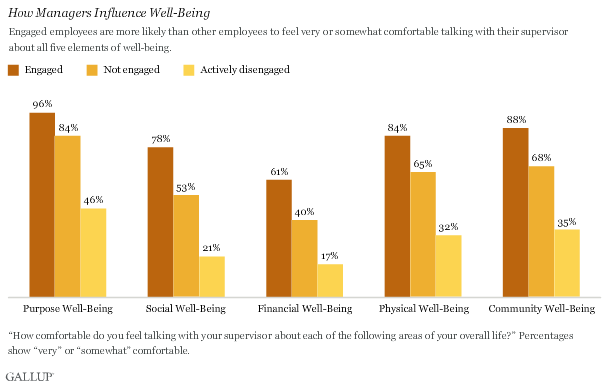- 1 in 5 adults in the US experiences mental illness in a year.
- Almost 50% of people in the US will experience mental illness at least once in their lifetime.
- 1 in 4 adults in the UK have been diagnosed with a mental illness.
- $100,000,000,000 – The economic loss of not treating mental illness effectively in the US
- This increases to over $200,000,000,000 when substance abuse is taken into account.
These statistics illuminate both the depressing state of mental health and the enormous financial costs of ignoring it.
Breaking down the costs
$225 billion dollars a year is a staggering number. But that is the economic cost of untreated mental illness and substance abuse.
According to recent studies, most of the cost comes from declines in work performance. These declines are due to absenteeism and presenteeism. Most employers track when and how often an employee is absent, but very few investigate how often employees go to work when they are sick. Combined, these employees can cost an employer about $1,600 per person, per year. 20% of the costs are attributed to absenteeism, while about 80% are due to presenteeism.
It seems clear that many employees go to work even though they will not be very productive. This loss of productivity is very damaging to companies, yet often overlooked.
The impact on employers
About 85% or employers offer Employee Assistance Programs (EAPs) but only 24% of employees use them.
Sometimes employers do not understand or value the impact that employee wellbeing and mental health has on the organization. Even though companies may have employee wellness programs, they only work if there is sustained effort at both the employee and employer levels to make them successful. Many of those types of programs also emphasize physical health and neglect mental health.
Companies may need to rethink this strategy as losses in productivity are due more to mental health issues than physical ones.
Depression alone costs employers between $44 and 200 billion a year, most of that coming from presenteeism. People who could be diagnosed as depressed but are not seeking mental health treatment use two to four times the amount of health resources as peers.
Stigma and company culture
Many people who have a mental illness understand the impact that it has on their lives and their jobs, but many do not do anything about it. These people are often aware of the stigma attached to mental health problems and may fear losing their job, not getting a promotion, or other consequences.
Over half of people surveyed in a recent study stated that they had not told their employer that they had been diagnosed with depression.
Almost 50% of those people said that telling their employer was risky because they could lose their jobs.
More than mental health
Mental health issues can also have many indirect costs to a company. If we look specifically at depression, we can see that depression is related to a host of other issues that also need to be investigated when looking at the costs of mental health.
Depression is often coupled with other illnesses. Many people who are depressed may also have symptoms of anxiety, PTSD, and substance abuse. These disorders can also lead to physical symptoms like chronic pain fatigue, difficulty sleeping, and gastrointestinal issues. The costs of the other problems are often more than the costs of the depression itself.
The importance of presenteeism
Most often, an employee’s productivity decreases when they are going through a stressful like event. The type of event and its symptoms can determine the reasons for the loss in productivity. Research has found a strong correlation between physical illness and absenteeism, and mental illness and presenteeism.
Presenteeism is often more common in employees who earn less, have poor health, and have children. Those employees may not feel they can afford to miss work, have no one else who can complete their tasks, cannot say no to obligations, worry that there will be more work to do when they return, and fear that they may lose their jobs.
The threats of workaholism
It has not been determined if mental health issues cause workaholism or if workaholism causes mental health problems, but it is clear that there is a correlation between the two.
Recent research, collecting data from over 16,000 adults found many links between mental health and workaholism. Compared to the general population workaholics had higher rates of ADHD, OCD, anxiety, and depression.
The engagement connection
As with workaholism, there is little research on the cause and effect relationship between employee engagement and employee well-being, but there is a correlation. A recent Gallup poll found that engaged employees are significantly more likely to discuss their well-being with their supervisors:
Source: Gallup
They also found that engaged employees are thriving in more wellness categories when compared with all employees.
Source: Gallup
Whatever the reasons (workaholism, lack of engagement, stigma, or poor leadership) mental health has huge financial consequences and is not going away anytime soon. The question then becomes, what can be done.
A mentally healthy organization
Engagement
Looking at data we can see that employee engagement has a positive effect on employee well-being. Managers, leaders, and supervisors need to continue to make efforts to improve engagement levels in order to increase the well-being of employees and to form a relationship where employees feel comfortable expressing problems.
Culture/stigma
Part of the solution is changing the company culture to be more accepting and open about mental illness. This acceptance and openness will lead to a decrease in stigma about mental health problems.
Part of this culture shift could include wellness practices like meditation and yoga, referrals to mental health professionals, improvements to EAPs, and mental health trainings. This may also include statements about the nondiscrimination of employees with a mental illness.
Training
Both leaders and employees would benefit from more training about mental health. Leaders and managers need to be trained in how to identify mental health problems and how to address concerns with employees. They need to know the warning signs as well as the reasons for needing to address these needs.
Employees should be trained in recognizing their own mental health difficulties as well as what they can do to improve their well-being. As part of the training, employers can make it known that employees can talk about their struggles and what the supports are within the company.
Assessment
Some companies may be able to assess their employees for difficulties. There are any different kinds of surveys and questionnaires that can help assess for mental health or risk factors for mental health. Employers could use those to be proactive about mental health issues. There are also many apps and online programs that can help employees track their own well-being.
Companies may also want to try to track presenteeism and workaholism in order to assess how often they are occurring and why. They both play a role in mental health and addressing them may impact the financial burden of mental health on the company.
Treatment
Some companies may refer out to mental health professionals, while others may hire a mental health professional for the organization. Either way, research states that mental health treatment does work.
After only three weeks of mental health treatment the number of employees that could be diagnosed with a mental illness decreased by 50%.
Even with just one session with a mental health professional can improve productivity and mental health.
For mental health treatment to be successful, employees also need to be willing to acknowledge and work on the problem. While these interventions will not fix all the mental health problems of an organization, they could be useful in addressing the stigma, being a leader of change, and starting the process of saving billions of dollars.
Download the eBook and learn how to use neuroscience to attract the right talent, retain high-performing employees and foster collaborative teams.
Image licensed from Depositphotos








Leave A Comment